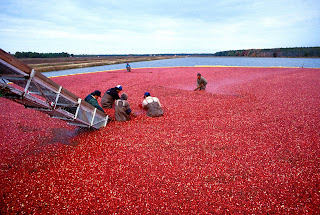Posted by Deryn Davidson, Boulder County Horticulture Extension Agent
Since this is the week of Thanksgiving, I figured taking
a closer look at the little, tart, red fruit that is a staple at most
Thanksgiving gatherings, would be apropos. Whether you like to make your sauce
from scratch (as my husband does) or if you prefer to open a can and let the
cylinder of wriggly sauce slide out (as my father does), the cranberry
is something we should all know more about!
The cranberry is in the family Ericaceae also known
as the heath or heather family. Other famous members of Eircaceae include the blueberry,
huckleberry, azalea and rhododendron. Members of this family prefer moist, acidic
growing conditions which we don’t find here in Colorado. Wisconsin is the largest producing state, Massachusetts is second and New Jersey comes in third. In New Jersey cranberries are known as "Rubies of the Pines" because they are cultivated in the sandy, acidic soil and waters found along the Pine Barrens (a heavily forested area of coastal plain). There are several species
of cranberry, but the one cultivated here in the United States, and most likely
to be found on your dinner plate, is Vaccinium macrocarpon.
 |
| Approximate range of Vaccinium: Red - common cranberry Orange - small cranberry Green - American cranberry |
All species of
cranberry have similar specific growing requirements. They like sandy soil, rich
in organic matter, along slow moving streams or in bogs. They don’t actually
grow in water, as some images may lead you to believe. They are a small,
evergreen shrub that trails along the ground.
 |
Herbarium "Vaccinium
macrocarpon — Flora Batava — Volume v14" by Janus (Jan) Kops
www.BioLib.de. Licensed under Public Domain via Wikimedia Commons
|
In late spring the
plant produces clusters of long pink flowers. According to lore, early
colonists saw the flowers and thought they resembled the neck, head and beak of
the sandhill cranes that were often found in areas that cranberries grew wild.
They called the plant CRANEberry. At some point the name morphed to CRANberry as we know it today.
 |
| "Vaccinum oxycoccos 120604" by Bernd Haynold - Own work |
The fruit of the cranberry have small air filled chambers called bladders and a waxy coating that allow them to float. If you've ever checked out a raw cranberry, you know they have a sort styrofoam nature to them. Native Americans used cranberries raw and cooked as food, medicine and dye for clothing. Mashed together with dried meat, they would make a long lasting pressed cake known as pemmican. Today they are most commonly found as a part of English Christmas dinners and American and Canadian Thanksgiving dinners. The fresh fruits are cooked down into a compote, jelly or sauce as an accompaniment to roast turkey. They are also sold dried and of course processed into juice. They area good source of vitamin C, dietary fiber and manganese.
Commercial farming and harvesting of cranberries today is done very similarly to how it was done back in the 1800s. Large areas of land are leveled and surrounded by earthen dikes to create boggy conditions. This allows growers to regulate the water level depending on what stage of the process they are in. Stem cuttings are planted and in three to four years, they begin producing fruit. Harvesting is done by two methods, wet or dry. The wet method, which is most common, involves flooding the bogs above the vines and then running mechanical water reels over the vines to shake the berries loose. Because the the fruit floats, once they are off the plant they can be pushed to the side and loaded into trucks.
The dry method uses a machine with teeth that pulls the berries from the vine and then moves them to large harvest boxes. Before the machines were developed, handheld cranberry scoops were used. Even with mechanical assistance, the dry method has higher labor costs and lower yield, but the fruit is less bruised and can therefore be sold fresh more easily.
 |
| Wet harvest method
Harvest photo By Keith Weller
USDA-ARS [Public domain],
via Wikimedia Commons
|
 |
| Dry harvest method by hand with "cranberry scoop" |
However you choose to enjoy your cranberries this year, hopefully now you can regale your friends and family with tidbits about the mighty cranberry!! Happy Thanksgiving!!


Sadly, growing up, I didn't even know that cranberries came in whole form--my grandma always served the canned ones for Thanksgiving. But it was fun to eat that cylindrical slice next to the turkey! Great blog, Deryn. I learned a lot!
ReplyDeleteAlison, I think you'll get a kick out of this classic Simpson's clip of Bart serving the "cranberry sauce!" https://www.youtube.com/watch?v=HLyXZMVcQfg
ReplyDeleteHa ha! Yes! I love it!
ReplyDeleteGreat blog Deryn! I remember going to the cranberry bogs in northern Wisconsin when I visited my grandparents every summer. I just read about a new sweet cranberry that the U. of Wisconsin has developed:
ReplyDeletehttp://www.npr.org/sections/thesalt/2015/11/24/457247226/cranberry-you-could-eat-without-sugar